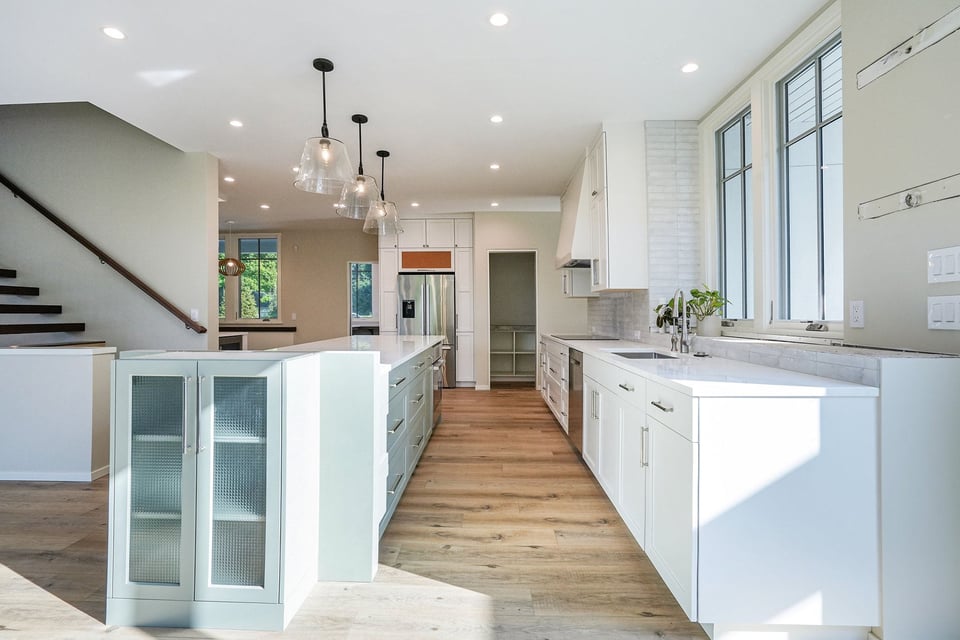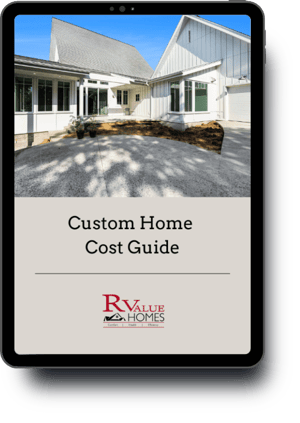6 Min Read
What’s the Latest in the Year to Start Building a Home in West Michigan?
Here in West Michigan, one of the most common questions we hear from folks ready to build is: “How late in the year can we start construction?” It’s a fair question. Our winters have a reputation. Between snow, ice, and those lovely lake-effect blizzards, a lot of people assume building shuts down as soon as the leaves hit the ground.
But here’s the truth: with the right methods (and the right builder), you don’t have to wait until spring to get your dream home moving. R-Value Homes has been building in West Michigan for over 20 years, and if we had a dollar for every time someone thought winter construction was a no-go, well, let’s just say we’d have an easier time paying for all that snow plowing.
We design and build custom homes that are high-performance, healthy, and energy-efficient from day one. And thanks to our expertise with Insulated Concrete Forms (ICF), frost-protected shallow footings (FPSF), and a meticulous pre-construction process, we’re able to build year-round without sacrificing quality or your timeline. So, if you’ve been putting off your build until “better weather,” stick around. It might just change how you plan your project.

Table of Contents
- Why Many Believe Winter Halts Construction
- How R-Value Homes Builds Year-Round (and Why Most Builders Don’t)
- Real-World Examples: Winter Projects That Didn’t Skip a Beat
- The Homeowner Advantage of Winter Starts
- Myth-Busting + The Long-Term Payoff of a Winter Start with ICF
- Start Your High-Performance West Michigan Custom Home in Any Season
Why Many Believe Winter Halts Construction
We don't have to tell you. Michigan winters don’t exactly scream “prime construction season.” If you’ve ever tried to dig a post hole in January, you already know why. Traditional builders face a few predictable headaches when temperatures drop.
-
Snow removal and site access. Heavy snow has to be plowed, shoveled, or salted (especially if your lot sits on a hill). Yes, it slows things down. No, it’s not a deal-breaker.
-
Storm delays. Sometimes you have to wait a day or two for a storm to blow through. That’s life in West Michigan. But unless it’s a major event, work typically resumes pretty quickly.
-
Frost heave risk. In traditional construction, ground frost can push up on the foundation or slab. That’s why many builders rush to pour foundations before winter and then twiddle their thumbs until spring.
-
Concrete curing issues. Standard concrete freezes instead of curing when it’s below 30°F. Traditional aluminum forms make this worse by sucking the heat right out of the pour. Translation? A lot of builders simply won’t pour in the winter.
And here’s where the misconception takes root: because most builders don’t have the right systems in place, people assume it’s impossible. We're here to set the record straight. It’s not the season that’s the problem, it’s the method.
How R-Value Homes Builds Year-Round (and Why Most Builders Don’t)
Most builders avoid winter starts not because it’s “impossible,” but because their methods just aren’t cut out for it. R-Value Homes has built our entire process around high-performance construction systems, which just so happen to laugh in the face of West Michigan winters. While many builders are twiddling their thumbs waiting for a thaw, we’re busy stacking, pouring, and moving your project forward. Our winter-proof toolkit includes:
-
Insulated Concrete Forms (ICF). Unlike aluminum forms that suck heat away, ICF walls hold the warmth in. That means we can safely pour concrete in temps as low as 15°F. (Yes, you read that right. Fifteen.)
-
Frost-Protected Shallow Footings (FPSF). By insulating footings, we prevent frost heave and keep foundations stable, even when the ground outside is frozen solid.
-
Insulated slabs. Every basement slab we pour is insulated underneath, protecting it from ground frost and helping your home stay more energy-efficient long-term.
-
Early comfort for trades. Because 100% of our exterior walls are ICF, your home is fully insulated before rough mechanicals begin. Our partners aren’t working in a wind tunnel. They’re warm, comfortable, and more efficient. Happy crews = better workmanship.
See more information about custom home construction timelines here to get a better idea of how much time you're truly saving.

Real-World Examples: Winter Projects That Didn’t Skip a Beat
Independent raters have verified that our homes score in the top 2% in West Michigan for performance. We’ve won awards for green building, zero-energy readiness, and custom home quality. More importantly, we’ve delivered for homeowners who were told by other builders to “wait until spring,” but ended up moving into their dream home sooner because we took a different approach.
You don’t have to take our word for it. Yes, you can absolutely start your custom home in winter and still end up with a schedule you can count on. Here are a couple of projects that prove winter builds can be downright smooth when done the R-Value way.
-
Vastu Shastra Sanctum. We kicked this custom home off in December using a combo of FPSF and ICF walls. Guess how many weather-related delays we had? Zero. That’s the power of pairing advanced building science with Michigan grit.
-
Old Mission Peninsula. This site sat on the west shore of Lake Michigan, aka home turf for snow, wind, and the kind of weather that makes most builders run for cover. While others were stalled out, we stacked and poured ICF walls in December and January, keeping the project on track and the builder impressed.
-
Everyday wins. On countless other winter builds, our trade partners rave about working inside a fully insulated shell where their tools don’t freeze and their fingers don’t go numb. Better conditions lead to better craftsmanship, plain and simple.
If you’d like to see what that looks like in practice, take a scroll through our custom home project gallery for inspiration and a closer look at the craftsmanship behind these results.
The Homeowner Advantage of Winter Starts
For many homeowners, the instinct is to hold off until the spring “building season.” On the surface, that makes sense. The ground is soft, the sun is shining, and you don’t have to worry about a snowstorm stopping your project. But here’s the problem: if you’re waiting for spring, so is everyone else.
And timing is just one piece of the puzzle, since there are many key considerations when designing a home in West Michigan that can influence how smoothly your project comes together. Instead of competing with dozens of other projects for labor, materials, and attention, the right builder can get your home a head start. That means:
-
You avoid the spring bottleneck. Many quality builder’s schedules clog up come April. Waiting until then doesn’t just delay your start, it often means you’re at the back of the line. By starting in January or February, you’re already out of the ground while others are still chasing permits.
-
Your move-in date comes sooner. It’s simple math: the later you start, the later you move in. Winter builds allow us to keep projects flowing, so you’re not stuck waiting until the following year to enjoy your new home.
-
Trade partners work in better conditions. Thanks to ICF walls and airtight shells, our mechanical, plumbing, and electrical teams work in a sheltered, temperate environment even in mid-winter. Tools function properly, installations are cleaner, and quality goes up.
-
You control your timeline, not the weather. Traditional builders cross their fingers for mild winters. We build with methods that minimize weather dependency, so your timeline isn’t at the mercy of Mother Nature.

Myth-Busting + The Long-Term Payoff of a Winter Start with ICF
Myth: “You can’t pour concrete in the winter.”
Truth: Traditional pours struggle below ~30°F, yes. But ICF construction insulates the formwork, so pours are routinely successful down to roughly 15°F. With proper planning (and sometimes timing pours for the warmest part of the day), low temps are rarely the showstopper people assume.
Myth: “Winter builds mean sloppy work.”
Truth: The opposite can be true. Because R-Value’s exterior is insulated early (ICF full walls + insulated slab + airtight details), trade partners work out of the wind and cold. Warm, dry working conditions = cleaner installations, fewer callbacks, and better finishes.
Why that matters long-term
-
Energy & comfort. Insulated walls, insulated slabs, and airtight construction translate to lower heating bills, steady indoor temps, and homes that perform like they were designed to (because they were). Independent rater results place our homes among the top performers in West Michigan.
-
Durability & low maintenance. Protecting the foundation from frost heave and constructing an insulated, moisture-managed envelope reduces long-term maintenance headaches (and expensive repairs).
-
Healthy indoor air. A tight building envelope paired with proper ventilation gives you control of indoor air quality with fewer drafts, less dust and pollen infiltration, and more consistent humidity control.
-
Net-zero readiness. When the shell is high-performance from day one, it’s far simpler (and cheaper) to add the HVAC, solar, or other systems required to reach net-zero targets later.
Put bluntly, starting in winter with ICF isn’t just a scheduling trick, it’s a way to build a better home from the ground up. You get a head start on your timeline and a long-term payoff in comfort, utility bills, and resale value.
Curious about the cost of a custom home in West Michigan right now? See our updated local cost information here.
Start Your High-Performance West Michigan Custom Home in Any Season
R-Value Homes serves Grand Rapids homeowners and nearby lakeshore communities, building custom, high-performance homes that perform year-round.
Ready to stop waiting for spring? We're ready to earn your business through careful listening and detail-oriented collaboration. Connect with us here to get started


.png?width=352&name=What%20is%20an%20Airtight%20Custom%20Home%20and%20Do%20You%20Need%20One%20in%20Grand%20Rapids_%20(1).png)

